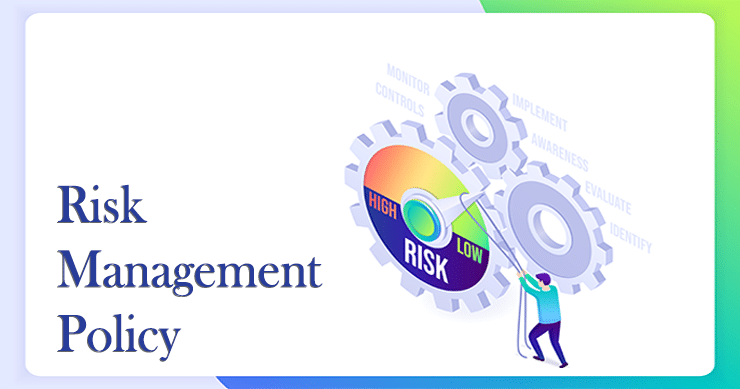What is a Risk Management Policy?
A risk management policy is a structured framework and set of guidelines established by an organization to systematically manage risks that could impact its objectives, operations, and overall success. This policy outlines the principles, processes, responsibilities, and standards guiding an organization’s risk management across its various functions.
A well-defined cyber risk management policy helps an organization proactively address potential threats, seize opportunities, make informed decisions, and allocate resources effectively.

How To Get Started on a Risk Management Policy
- Assess the Risk Landscape
Before embarking on any risk management strategies in cyber security, it is imperative to assess your organization’s digital landscape thoroughly. Identify critical assets, evaluate vulnerabilities, and understand potential threats. This comprehensive risk assessment will serve as the foundation for your internal and vendor risk management policy, as well as your reputation risk management policy, providing valuable insights into where your organization is most exposed and allowing you to prioritize your efforts.
To accurately assess risks, organizations must categorize them based on their severity, likelihood of occurrence, and potential impact on the organization. This can be achieved through risk assessments that utilize quantitative, qualitative, or hybrid methodologies. Quantitative assessments involve assigning monetary values to risks and calculating potential financial losses. On the other hand, qualitative assessments focus on the qualitative impact of risks, such as their potential to disrupt operations or damage reputation.
- Choose a Risk Management Framework
Choosing an appropriate risk management plan is pivotal in shaping your risk management strategy. Risk management frameworks offer structured guidelines and best practices for identifying, assessing, and responding to risks. These frameworks can be tailored to an organization’s needs, considering factors such as industry, risk tolerance, compliance requirements, and technological environment.
Start Getting Value With
Centraleyes for Free
See for yourself how the Centraleyes platform exceeds anything an old GRC
system does and eliminates the need for manual processes and spreadsheets
to give you immediate value and run a full risk assessment in less than 30 days
Following is a list of some of the most widely used risk management frameworks:
- NIST Cybersecurity Framework: The NIST CSF provides a set of cybersecurity best practices, guidelines, and standards that can be customized based on an organization’s risk tolerance and resources. It focuses on key areas like Identifying, Protecting, Detecting, Responding, and Recovering.
- CIS Controls: The CIS Controls offer a prioritized set of actions to enhance an organization’s cybersecurity posture. These controls are organized into different implementation groups, making it easier for smaller businesses to start with the basic controls and gradually work towards more advanced ones.
- ISO 27001: ISO 27001 is an internationally recognized information security management system (ISMS) standard. While it can be tailored to any organization, smaller businesses may find the “ISO 27001 Small Business Implementation Roadmap” useful in simplifying the implementation process.
- CMMI Cybermaturity Platform: The CMMI Institute offers a Cybermaturity Platform that provides a structured approach to improving cybersecurity practices. It’s designed to be adaptable for organizations of all sizes, including smaller businesses.
Risk Management vs. Risk Assessment
It’s essential to differentiate between risk management and risk assessment. While risk assessment is a specific part of the risk management process, risk management itself is a continuous and dynamic strategy. Risk management involves identifying potential risks, evaluating their likelihood and potential impact, and responding strategically. On the other hand, risk assessment focuses on identifying and analyzing risks, categorizing them by likelihood and severity, and outlining potential consequences.
A risk management policy documents the entire process, from identifying and evaluating risks to mitigating them. It encompasses risk control monitoring, cost-benefit analysis, and considerations of financial impacts. While often confused with risk assessment, which focuses on identifying and analyzing risks, a risk management plan goes beyond assessment to include the entire risk management process.
Build Your Risk Strategy Policy With Centraleyes
The effectiveness of a compliance risk management policy depends on how well it aligns with your organization’s unique characteristics, risk appetite, and available resources. It’s also important to seek guidance from cybersecurity professionals or consultants who can help tailor these frameworks to your needs.
Centraleyes enables stakeholders to easily create and define frameworks to fit their needs or choose from tens of pre-populated integrated risk and compliance frameworks. The best part? Centraleyes allows for a quick, automated compliance process by mapping shared controls across multiple frameworks.
The Centraleyes platform is scalable and can be easily adjusted as security needs evolve. It includes integrated risk assessment tools, robust reporting and analytics capabilities, and third party risk management policy strategies.
Start Getting Value With
Centraleyes for Free
See for yourself how the Centraleyes platform exceeds anything an old GRC
system does and eliminates the need for manual processes and spreadsheets
to give you immediate value and run a full risk assessment in less than 30 days





